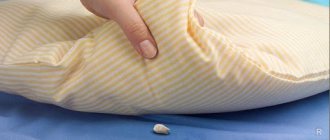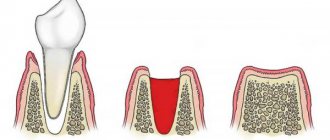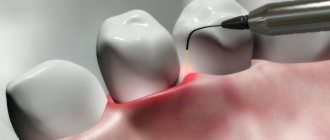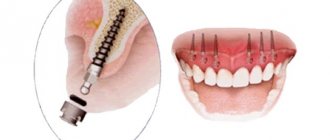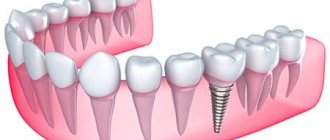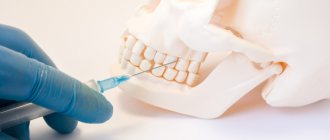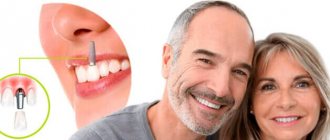Author of the article Voznyuk Vladimir Aleksandrovich Maxillofacial surgeon-implantologist of the highest category
Work experience: 28 years.
Implantation methods Implantation of two teeth in a row Place an implant on two teeth In case of scattered missing teeth Is osteoplasty necessary Stages of the operation Timing Price Guarantees Contraindications Alternatives
The absence of two or more teeth in a row is fraught with the development of serious functional problems - disruption of the entire dental system and temporomandibular joints. Dental implantation is the most physiological way of replacing teeth. A titanium root completely replaces a natural tooth, taking over all its functions. The implantation option depends on the clinical features - the location and extent of the defect, the condition of the bone tissue.
Implantation methods in the absence of 2 teeth
Dental restoration is carried out using two protocols - two-stage (classical) with delayed loading or one-stage with immediate loading of a denture. It is also possible to install an implant in the socket of an extracted tooth.
Classic implantation from 28,000 rub.
More about prices
One-stage implantation from 41,000 rub. 35,000 rub.
More about prices
Implantation immediately with tooth extraction from RUB 44,100. RUB 36,100
More about prices
Classical
- It is carried out in 2 stages - implantation and installation of an orthopedic structure are separated by a time interval of 2-6 months (implant healing time).
- Classic two-part implants are installed (the root part and the abutment are separate components).
- Implants are installed using the patchwork method - through an incision and peeling of the gums.
- After installation, the implant is closed with a plug and sutured until complete healing.
- After 2-6 months, the gum is cut again, a gum former is fixed to the implant, then an abutment and a permanent crown.
- During the engraftment of the implants, the defect is compensated with a removable immediate prosthesis Butterfly.
One-stage
- It is carried out in stage 1 - the orthopedic structure is installed on the implants immediately after their implantation (within 72 hours).
- Classic two-part implants are used (the abutment is screwed on immediately) or one-part implants (the artificial root and the abutment are a single structure).
- Implants are implanted using a minimally invasive method - through a micropuncture of the gums.
- Immediately after implantation of the artificial root or on the 2-3rd day, temporary crowns or an adaptive prosthesis are installed. After complete osseointegration of the implants, re-prosthetics with a permanent structure is performed (after 10-12 months).
One-stage after tooth extraction
- The artificial root is implanted non-surgically into the socket of the extracted tooth.
- Both one-piece and two-piece implants are used.
- Depending on the clinical situation, immediate or delayed loading of the prosthesis is possible.
The implantation method depends on the location and extent of the defect. When restoring the front row, if the situation allows, preference is given to single-stage protocols with immediate loading. The installation of two implants in the masticatory region is often carried out using the classic two-stage method with delayed prosthetics.
Features of implantation of the upper and lower jaws
Each of the jaw bones has its own structural features. For example, in the lower jaw bone tissue is most often found in types D1 and D2.
Options for dental implantation in the lower jaw >>
After tooth loss, the bone shrinks less, remains quite strong and its structure is usually uniform. Here, most situations are resolved quite simply - you can use fewer implants, and they take root faster. Approximately from 2-3 months, depending on the model; by the way, the healing process today is most often accompanied by the simultaneous use of new teeth.
The situation with the upper jaw is more complicated. The bone itself is “softer” - more porous, type D3. Just above the jaw bone in the distal (lateral) sections are the maxillary or nasal sinuses. In fact, these are cavities that have a fairly thin shell.
Types of methods for installing implants for the upper jaw >>
After tooth loss due to cellular malnutrition, the spongy portion of the jaw bone begins to decrease in size (a process called atrophy). The softest bone type, D4, is most commonly found in this area. The vacuum causes the bone to lose volume in height, and the bottom of the maxillary sinus, accordingly, is much closer than before. What does this mean? Because when installing implants (if the doctor selects them incorrectly in length), there is a high risk of damage to the sinus membrane - you can simply pierce it with the tip of the implant (officially this process is called perforation).
In addition, the bone tissue of the upper jaw is looser, so two-stage crestal implants take longer to take root - at least 4 months, even the best models, and in general - about six months.
It is precisely because of the difference in the anatomical structure of the upper and lower jaws that it is necessary for each individual patient to select not only implant models, but also protocols for their installation. You can rest assured in the individual approach of the Smile-at-Once clinic: we will select only the solution that will last you for the rest of your life, because we give a lifetime guarantee for treatment.
We restore teeth without complications and for sure! 3D diagnostics and planning help doctors plan the placement of implants with maximum accuracy and taking into account the individual characteristics of the jawbone structure!
Make an appointment
What patients say about treatment
Natalia Alexandrovna With words of gratitude for the new smile! After all-on-4 implantation
Rakhilya Khairovna 2 years after basal dental implantation
Irina Arkadyevna After complex implantation of all-on-6 with immediate loading
Konstantin Aleksandrovich New teeth immediately and forever! After complex all-on-4 implantation
Natalya Vladimirovna 1.5 years after all-on-4 implantation: re-prosthetics
Alexander Sergeevich New teeth in 3 days and forever! Thanks to the doctors!
Ian Michael After comprehensive all-on-4 dental restoration
Samvel Zavenovich Re-prosthetics after complex implantation all-on-4
Surkova Lyubov Anatolyevna 1.5 years after all-on-6 implantation
Tatyana Borisovna With words of gratitude to the doctors for a new smile!
Nadezhda Aleksandrovna Selfie and review after implantation of all teeth, including the use of zygomatic implants
— With words of gratitude for the new smile! After all-on-4 implantation
With your attending physicians after complex implantation of all teeth using the all-on-4 protocol. On one jaw - with delayed loading (a removable denture is installed while the implants are healing), on the second jaw with fixation of a frameless prosthesis using the “teeth in 1 day” technology. An individual solution is selected for each patient! Taking into account the clinical picture and condition of the oral cavity.
Natalya Alexandrovna
With words of gratitude for a new smile! After all-on-4 implantation
Doctor: Specialization: Experience:
3 days
View all reviews
— 2 years after basal dental implantation
With words of gratitude for a new smile! After basal dental implantation. In the photo - with the attending physicians: maxillofacial surgeon, implantologist Roman Bespalov and orthopedist Stanislav Chorny immediately after implantation and prosthetics. And also after 2.5 years - comprehensive hygiene as part of free service.
Rakhilya Khairovna
2 years after basal dental implantation
Doctor: Specialization: Experience:
3 days
View all reviews
— After complex implantation of all-on-6 with immediate loading
Photo as a keepsake after complex implantation. Together with the doctor, the patient chose the all-on-6 solution using original Nobel Biocare implants with immediate installation of a fixed prosthesis. In the photo - with orthopedic dentist Viktor Nepochatykh, who directly performed prosthetics on implants.
Irina Arkadyevna
After complex implantation of all-on-6 with immediate loading
Doctor: Specialization: Experience:
3 days
View all reviews
— New teeth immediately and forever! After complex all-on-4 implantation
With a team of doctors who performed complex dental restoration using the all-on-4 protocol with immediate loading of a fixed prosthesis - implant surgeon Alexander Vasiliev and orthopedic dentist Dmitry Creamer.
Konstantin Alexandrovich
New teeth immediately and forever! After complex all-on-4 implantation
Doctor: Specialization: Experience:
3 days
View all reviews
— 1.5 years after all-on-4 implantation: re-prosthetics
With orthopedic dentist Zhargal Dulgarov after changing the adaptive prosthesis to a permanent one. The patient began treatment in our clinic back in May 2020. During this time, all-on-4 implantation was performed on original Nobel Biocare implants with immediate and delayed loading. A permanent prosthesis was installed on one jaw in November, now it’s time to re-prosthetize the second jaw. The patient chose a comfortable option made of ceramic composite – a durable and very aesthetic material.
Natalya Vladimirovna
1.5 years after all-on-4 implantation: re-prosthetics
Doctor: Specialization: Experience:
3 days
View all reviews
— New teeth in 3 days and forever! Thanks to the doctors!
A beautiful smile and a great mood after complex implantation with immediate loading according to the all-on-4 protocol. A non-removable adaptive prosthesis was installed on the 3rd day, which allowed the patient to return to a full life immediately. In the photo - with one of the attending physicians who was responsible for the prosthetics stage - orthopedic dentist Bair Sambuev.
Alexander Sergeevich
New teeth in 3 days and forever! Thanks to the doctors!
Doctor: Specialization: Experience:
3 days
View all reviews
— After complex dental restoration all-on-4
Our patient from the UK flew to Moscow on business and at the same time decided to undergo comprehensive dental restoration. For this purpose, the original all-on-4 protocol was chosen on Nobel Biocare implants with the installation of a fixed prosthesis immediately. The result is full functionality of the teeth and high aesthetics of the smile! In the photo - with one of the attending physicians, orthopedic dentist Viktor Nepochatykh.
Ian Michael
After comprehensive all-on-4 dental restoration
Doctor: Specialization: Experience:
3 days
View all reviews
— Re-prosthetics after complex implantation all-on-4
With words of gratitude for a new life! Re-prosthetics after complex implantation of all teeth using the all-on-4 protocol on original Nobel Biocare implants. At the first stage, an adaptive prosthesis was installed, at the second - from a durable ceramic composite.
Samvel Zavenovich
Re-prosthetics after complex implantation of all-on-4
Doctor: Specialization: Experience:
3 days
View all reviews
— 1.5 years after all-on-6 implantation
With orthopedic dentist Dmitry Creamer almost 1.5 years after complex implantation using the all-on-6 protocol on Nobel Biocare brand implants. Re-prosthetics were carried out using a complex of digital diagnostics and planning to produce the most comfortable prosthesis.
Surkova Lyubov Anatolevna
1.5 years after all-on-6 implantation
Doctor: Specialization: Experience:
3 days
View all reviews
— With words of gratitude to the doctors for a new smile!
With the attending physicians - ch.l.h., implantologist Roman Bespalov and orthopedic dentist Dmitry Sidorov - after complex all-on-4 implantation with immediate loading with fixed adaptive prostheses. New teeth immediately and forever! With a lifetime warranty and free service.
Tatyana Borisovna
With words of gratitude to the doctors for a new smile!
Doctor: Specialization: Experience:
3 days
View all reviews
— Selfie and review after implantation of all teeth, including the use of zygomatic implants
With words of gratitude to the attending physicians - a review and photo after prosthetics using the all-on-4 technology: “Many thanks to Evgeniy Aleksandrovich for the excellent job done! Yuri Alexandrovich for his beautiful smile! May God bless you with health and prosperity. Happy New Year!"
Nadezhda Alexandrovna
Selfie and review after implantation of all teeth, including the use of zygomatic implants
Doctor: Specialization: Experience:
3 days
View all reviews
Implantation of two teeth side by side
Front teeth
When restoring the anterior group, any implantation method can be used. The doctor selects the treatment option depending on the initial situation. They use classic implants of small diameter and sufficient length, with aggressive threads (large at the bottom and small at the top) for atraumatic installation and stability in the bone. Basal, compression models are not used due to insufficient chewing load resources on the implanted artificial root.
When replacing 2 teeth in a row, 2 implants are implanted, each of which is covered with a crown immediately or after implantation. The method of prosthetics depends on in which zone of the frontal region the defect is localized. It is better not to load teeth in the risk zone (1, 2, 3) immediately, since the patient will bite off food with them, which will lead to displacement of the implant. In some situations, immediate loading is possible (at the patient's responsibility) with the removal of the crowns from the bite to preserve aesthetics.
Chewing teeth
When implanting the chewing zone, the treatment option is selected individually - it all depends on the indications, the number of missing teeth, and the condition of the jaw bone. Implants are placed in the lateral sections that can withstand increased chewing load. The method depends on the size of the defect:
- If there are no two teeth in a row, and the distance between them is small, replacing two units next to each other is carried out using the classical method - 2 titanium roots are implanted, each of which is covered with a crown. Since the posterior teeth are actively involved in chewing, immediate loading of crowns on classical implants is not carried out in order to avoid displacement of artificial roots. Until the implants are completely implanted, the dentition is filled with the Butterfly immediate prosthesis.
- If we are talking about replacing large teeth (6, 7) and a defect of a large extent, it is possible to install 3 one-piece implants (implanted at an angle, in areas with more suitable bone tissue in density and volume, bypassing the roots of adjacent teeth), which are covered with a bridge of 2 artificial crowns. Due to the design of one-stage implants fixed into the deep layers of the jaw, the installation of the prosthesis is carried out immediately. The orthopedic system acts as a splinting structure that combines the prosthesis and implants into a single system, stabilizes them in the bone and prevents them from loosening.
When implanting teeth that do not actively participate in the chewing process (4.5), immediate loading of even classical implants is possible - lightweight metal-plastic crowns are installed, removed from the bite (made a little smaller in height). At the patient’s request, it is possible to install crowns in the risk zone immediately, but in this case, the clinic does not provide a guarantee if the implantologist’s clear recommendations are not followed.
How many implants need to be placed?
In the absence of three adjacent units of the dentition, the following are placed:
- 2 implants - are introduced along the edges of the defect, serve as support for a permanent bridge prosthesis consisting of three welded crowns (two of them are fixed to titanium roots, and the central one is hinged);
- 3 implants - replace each lost tooth and, after healing, are covered with separate crowns.
Which option will be chosen and which orthopedic structures will be used depends on the location of the defect.
Front teeth
Implantation of three adjacent incisors has a number of features due to increased aesthetic requirements:
- white zirconium abutments are used that are not visible through the gum;
- if necessary, plastic surgery of soft tissues is performed;
- smaller implants are selected for installation in the narrow bone of the frontal jaw;
- Crowns made of lightweight materials with bite relief are placed as temporary prostheses.
If three teeth in a row are missing from the front, both restoration options are suitable (2 and 3 titanium roots), however, the installation of three implants followed by prosthetics with single crowns is preferable. In this way, identity to natural teeth is achieved, an even gingival contour is formed, which guarantees maximum aesthetics.
Chewing teeth
When replacing three adjacent units of the lateral jaw, high demands are placed on the functionality of the structures. They must be securely fixed, withstand severe chewing loads, and prevent atrophic processes.
In such cases, we choose the option of installing three implants with single crowns, since a bridge on two titanium roots does not provide uniform pressure on the bone and leads to its resorption.
When implanting several teeth in a row, three or more, it is important to assess the condition of adjacent units. If they previously served as supports for a bridge, then, as a result, they are destroyed and cannot be restored - they will have to be removed and work with a more extensive defect.
Attending doctor
Strigin Vladimir Igorevich
Orthopedic doctor. Specialist in implant prosthetics
Cost and terms
Is it possible to place one implant on two teeth?
To install a prosthetic structure, support is needed. Theoretically, the following options are possible:
- Installation of 1 implant and 2 crowns
This means that one crown will be fixed on the implant, and the second will remain suspended. An unsupported prosthesis, when subjected to load, acts as a lever that will simply loosen and dislocate the implant from the bone. - Installation of 1 implant and a bridge of 3 artificial crowns
Based on the implant and your own tooth. With this option, a depreciation effect occurs. A living tooth in the jawbone has mobility, an artificial root has maximum stability. The result of this difference is loosening and rejection of the implant.
In the absence of two adjacent dental units, it is better to choose two implants, each of which is covered with an artificial crown.
What is two-stage and one-stage implantation? What's better?
Everything is simple here. One-stage implantation is when the surgeon places an implant and immediately puts a gum former on it*. Thus, the entire surgical part of the treatment takes place in one stage. Two-stage implantation, accordingly, takes place in two stages. First, the surgeon places the implant, closes the hole in it with a plug, closes the whole thing with gum and sutures it tightly. Those. in the mouth there are no signs that anything was placed there. After 3-4 months (on average), when the implant has taken root, the time comes for the second stage. Then the surgeon makes a small incision in the gum, exposes the implant, removes the plug from it, and installs a gum former in its place. After this, the patient waits 10-14 days for the gums to “mature” so that prosthetics can begin.
This is what the doctor’s sequence of actions looks like at the first stage of the two-stage technique...
... and so on at the second stage. During one-stage implantation, instead of screwing in the plug (1C), the gum former is immediately screwed on. This "skips" the need for repeated incisions (2A).
But not only implantation is one- or two-stage. The implants themselves are the same. Single-stage implants are a monolith in which the implant itself and the abutment are a single whole.
They are placed very rarely. They are completely unsuitable for high-quality aesthetic solutions. Two-stage, the most common in modern dentistry, imply that the implant is on its own, and all the spare parts for it (plug, gum former, abutments) are on their own. This is no longer a monolith, but a collapsible structure.
What's better? Place the implant in one stage or two? On the one hand, it is certainly better to “suffer” at one time, immediately place a gum former, and never have to deal with the surgeon’s scalpel again. On the other hand, a tightly sutured implant can easily “take root” without contact with an oral infection, and it is unlikely that anything can prevent it from successfully doing so. Therefore, the doctor must decide whether implantation can be performed using a one-stage protocol (which is more convenient for the patient) or a two-stage protocol (which is less risky), based on many factors. This includes the location of the tooth (the anterior ones are often done in one stage, and they do not place a gum former, but a temporary crown at once), the level of hygiene and bad habits (with poor skills, active smoking, it will be better for the implant not to come into contact with the oral cavity), the primary stability of the implant (two-stage the protocol is preferable if there was little bone, and the doctor performed sinus lifting or bone grafting, since even the slightest load on the implant can disrupt its stability in the bone, and it will not “take root”).
This concludes the second part, but the series will continue...
Read other articles on dental implants:
Dental implantation in questions and answers. Dedicated to those who have not yet decided... Part 1.
Dental implantation in questions and answers. Dedicated to those who have not yet decided... Part 2.
Dental implantation in questions and answers. Everything you need to know about dental implant surgery. Part 1.
Still have questions? Do you want to keep up to date with the latest work and watch smile transformations online? Add as a friend: Facebook, Youtube, Instagram, VKontakte
Tags:
- Implantation
Tell your friends:
- Add a comment
Implantation for isolated absence of 2 teeth
There are situations when a patient is missing one tooth in different parts of the jaw or on different jaws. If two teeth are missing at the same time, one upper left and the other lower right, 1 classic implant is installed with a delayed or immediate crown load. The type of implant structure used, the method of implanting an artificial root, and the timing of prosthetics depend on the area where the defect is located.
If a tooth is missing in an area with a high risk of displacement of the implant during chewing, prosthetics are performed after the artificial root has completely engrafted. In some cases - immediately, with the removal of the crown from the chewing process. This option is used when implanting anterior incisors to preserve aesthetics, but the patient must understand the possible risks.
If the missing teeth are on opposite sides, it is better to space out the implantation. After installing artificial roots, it will be necessary to limit chewing loads on the surgical area, so in order for the patient to retain the ability to chew food on at least one side, it is better to carry out implantation one at a time.
When can an implant be placed, and when should an implant not be placed?
Let's start with problems when implantation was postponed
Let’s not go into the reasons now - either due to the patient’s ignorance, or he is lazy, or there is fear of the operation. It doesn't matter now. The main thing is that there is a time delay in installing the implant. Let's understand where exactly this problem arises if the patient nevertheless decides to postpone implantation.
The very phrase “bone tissue has resolved” does not sound scary and does not frighten a person who does not understand dentistry.
What are the consequences and dangers of bone tissue resorption?
Let’s say we can consider the overall picture: if a patient has no teeth, then he chews food worse, therefore, he has worse digestion, etc. and so on. That is, the patient’s body as a whole suffers more. And if you look in particular, that is, into the oral cavity, then it is easier - it’s just inconvenient to chew food. Although some people manage to chew food without teeth at all. How they manage to do this is difficult to say.
In general, a person adapts to many problems
First he gets used to the absence of one tooth, then two or three, etc. then it loses even more, chewing food becomes not such an important factor. But in vain.
That is, a person is adapting to the created conditions with his teeth, or more precisely, to their absence. And then, when he gets all his teeth back - during the restoration of both the upper and lower jaws, the person becomes... unusual for chewing! They even ask again: “How can I chew it now? I’m used to doing it differently.” It sounds quite anecdotal, but the patient is not laughing at this moment; he has to learn to chew food normally again.
What other factor can attract the attention of the patient, especially women?
, regarding the situation with a missing tooth?
The aesthetics factor of the anterior teeth is very important
If you lose one or two teeth in the chewing department, no one will notice a violation of aesthetics. And if in the anterior region, then yes, the speed of decision-making about installing an implant and further prosthetics is very high, since the patient wants to eliminate a visible dental defect as soon as possible.
Plus, due to the absence of front teeth, there is a retraction of soft tissues, which is visible to the eyes of strangers.
For some reason, patients almost always postpone restoration of the chewing group of teeth through implantation “for later,” although this is wrong
.
It is necessary to restore the chewing area so that it bears the chewing load. If the chewing zone is not restored, then, oddly enough, the frontal, anterior zone of the teeth begins to suffer first.
The front teeth take the load of the chewing teeth and become overloaded: the front teeth begin to bear a load many times greater than what Nature assigned them. As a result of such maximum loads, the ligaments are stretched and the teeth become loose. And at this moment the patient begins to ask himself (and the doctor): “Why are my teeth loose?” And he even diagnoses himself - periodontal disease or periodontitis. But in fact, the patient does not have any periodontal disease or periodontitis; the chewing teeth just need to be restored.
When a patient comes to me at the German Center for aesthetics, then always, if he has a lack of chewing teeth or there is a functional deficiency (that is, crowns that are not restored correctly, chipped crowns, teeth that are destroyed or fillings that are not restored very well), then I always I draw his attention, telling him that first he needs to restore his chewing teeth.
See how this happens in the example of one patient:
And only then – we begin to talk about restoring a smile, about aesthetics:
Because, having made the chewing teeth, we will move the load to its “native” place, normalize the load in the frontal region, and the work that we will then do with the front teeth - veneers, crowns - this work will last happily ever after for many years.
Consent to dental implantation “immediately” and “not immediately”
What happens if the patient:
- immediately agrees to install the implant,
- Will he agree to have an implant installed after some time?
How is the implant installed in these cases? The difference in implant placement in these cases is large
.
Case 1.
If a patient comes and says: “I have a bad toothache and I want to get an implant,” you must first understand why his tooth hurts. If this tooth hurts because it is mobile, and for some reason the mobility affects the gums - that is, the gums actually hurt, this is one case.
Case 2.
But if the tooth hurts, and a large cyst or abscess is identified in the area of the tooth, then this is a different case. Why does an abscess form? It is formed due to the destruction of bone tissue, due to the localization of infection in this destroyed area. And this infection was activated, and a purulent process had already appeared. And this is exactly what hurts. Naturally, in this case, the implant cannot be installed immediately. Because the surrounding tissues are infected, and even if everything is cleaned well and an implant is placed (if there is somewhere to place it, if the bone tissue is not completely destroyed), then there is a high probability of implant rejection. The implant may not take root and may not generate osteogeneration, because the body has not yet stabilized the area of inflammation and has not brought it “in order.” The processes of bone tissue regeneration and the processes of fouling of the implant with bone tissue will not be carried out; the body will simply reject the implant as a foreign body.
Case 3.
If the patient comes, and for some reason he needs to have a tooth removed, and there is an infection (granuloma or small cyst).
Dental implantation if a cyst is detected
People come and say: “I was diagnosed with a cyst. What to do?". The concept of a cyst is very different. First it is a granuloma, then it is a cystogranuloma, and only then it is a cyst. It depends on the size, we won’t go into details now. If this is an inactive phase, that is, if this infection has not yet turned into a purulent infection, then by removing the tooth and removing such a “cyst” or granuloma, and carrying out antiseptic treatment of the place where this focus was located, then in this case you can immediately install an implant . In this situation, it is possible to use a laser. We use a laser to go through and disinfect canals and bone structures.
The only issue that arises is replacing the removed tissue with artificial one. But this all depends on the volume of the defect that formed after removal of the cyst or granuloma.
That is, if the patient has an active phase
inflammation, then an implant
cannot
.
If the inactive phase
, then the tooth implantation after removal
will be successful
.
But there is also a dependence on the location of the granuloma (cyst, cystogranuloma) in relation to the bone tissue. It happens that in the frontal region the anterior bone wall is simply destroyed by this pathogenic structure. And there is virtually no bone tissue. She is not physically there. In this case, you need to perform bone grafting and it takes time for this wall to recover.
Usually, after removal, after inflammation has subsided, it takes at least two months for the body to recover.
When is it not necessary to place an implant?
Such situations 100% include the area of wisdom teeth; removal of “eights” does not require the installation of implants
Is bone augmentation necessary?
One of the limitations to the installation of implants is the lack of bone tissue volume or its atrophy. It occurs as a result of a long toothless period, and bone loss begins almost immediately after the loss of a tooth by the root. The solution is to increase bone volume (osteoplasty in the lower jaw, sinus lift in the upper jaw) or protocols that allow implantation without bone grafting.
- With classical two-stage implantation, bone tissue augmentation in case of its deficiency is mandatory . For moderate and severe atrophy, osteoplasty is performed in a separate stage. Implants are installed after implantation of the osteoplastic material (after 2-3 months). If there is a slight loss of bone, replanting of osteoplastic material is possible simultaneously with the implantation of an artificial root.
- When installing one-stage implants, increasing bone volume in a separate stage is performed only in conditions of critical deficiency. In case of moderate atrophy - simultaneously with the installation of an artificial root; in case of slight recession, bone growth can be avoided by installing titanium roots at an angle in an area with sufficient volume and density of bone tissue.
One-stage protocols use implants that are attached to the cancellous bone and deeper basal layers that are not subject to atrophic processes.
What determines the choice of implants in the absence of three teeth in a row?
If there are no contraindications, the doctor determines the appropriate implantation method. This takes into account:
- type of alveolar process;
- thickness of the mucoperiosteal flap;
- width and density of bone tissue;
- size of lacunae-loops of cancellous bone;
- topographic-anatomical parameters of the jaw;
- implantation site
Then the required material and shape of the rods and the design of the prosthesis are selected. The most widespread are root-shaped (screw and cylindrical) rods . Basal systems are indicated when it is impossible to build up atrophied bone, but they can withstand less load. When the alveolar process is narrow, mini-implants are used for bridges of short length and when there is insufficient bone mass. They are implanted into soft tissue.
For implantation of chewing teeth, artificial roots made of pure titanium and its alloys or tantalum are suitable. To replace frontal units - made of zirconium dioxide (due to its white tint, it does not shine through the gums).
Installation of a zirconium dioxide bridge for the restoration of anterior dental units
The number of rods is determined based on:
- condition of the jaw bone;
- requirements for the reliability of the implantation system;
- financial capabilities of the patient.
Stages of treatment
1
2
3
4
Consultation
Examination, questioning, selection of treatment protocol.
Diagnostics and preparation
Comprehensive examination (orthopantomogram, CT), testing. Treatment of teeth and gums (if necessary), hygienic cleaning, 3D planning of surgery.
Implant installation
Carried out in accordance with the selected protocol. In a two-stage procedure, titanium roots are implanted using a patchwork method; in a one-stage procedure, titanium roots are implanted through a micropuncture of the gum or into the socket of an extracted tooth.
Prosthetics
Delayed loading with a prosthesis during classical implantation (a permanent orthopedic system is installed on artificial roots after they have completely engrafted).
Immediate loading with a one-stage method (on days 1-3, adaptation crowns or a prosthesis made from the patient’s casts are installed on the abutments. After 10-12 months, re-prosthetics are performed with a permanent structure). The one-step protocol includes one more stage - surgical removal of the affected tooth or root.
What is better if 3 teeth are missing - dentures or implants?
Let's look at possible recovery methods:
- Bridge prosthesis
A fixed structure consisting of several crowns is fixed to adjacent teeth with a special dental adhesive-cement. Before installing the prosthesis, the supporting units are depulped and ground. If there are no last teeth in the row, it will not be possible to install such a prosthesis, since there is no support. - Removable denture
A structure consisting of artificial gums with soldered crowns, fixed on the gums, held by hooks to adjacent teeth. Prosthetics do not require filing or removing the nerve of nearby supporting teeth. But such fastening is unreliable; food particles get under the prosthesis. - Implantation
In the absence of several elements, individual implants (titanium roots) are implanted into the “free” places, which are loaded with a fixed prosthesis on the 2-3rd day (with a one-stage protocol) or after the implants have healed (with classical implantation).
Implantation is the best way, as it provides:
- safety of neighboring teeth - they do not need to be depulped and ground down;
- aesthetic result - artificial teeth on implants are difficult to distinguish from natural ones;
- bone preservation - with an implant, the bone tissue experiences stress and does not decrease in size;
- reliability, durability - implants can withstand significant chewing loads and last 30 years or more with proper care.
How long does it take to install 2 implants?
| Classic method | One-step method | |
| Operation duration | 1-1.5 hours | 30-40 minutes |
| Healing time | 14-21 days | 5-7 days |
| Timing of prosthetics | Permanent crowns after complete osseointegration (after 2-6 months) | Adaptive prostheses for 1-3 days after implantation |
| Permanent prosthetics | 2-6 months | 6-12 months |
| Preliminary osteoplasty | 4-6 months | Simultaneously with implantation |
Price
When implanting 2 teeth at once, the cost of treatment is determined depending on the protocol used, additional measures, type of crowns, etc. At the ROOTT clinic, dental implantation is performed on a turnkey basis:
- Installation of a classic ROOTT FORM implant - for implantation without installing a crown (if it was carried out with tooth extraction - removal is paid separately) - RUB 28,000. for 1 implant .
- Installation of a one-stage implant (Switzerland, Trate AG) with an “ALL INCLUSIVE” crown (if it was carried out with tooth extraction, the removal is paid separately) - 35,000 rubles. for 1 implant .
- One-stage installation of a classic ROOTT FORM implant along with removal and immediate loading with a crown - RUB 44,100. for 1 implant .
Turnkey titanium root installation includes:
- diagnostics;
- consultation with an implantologist, orthopedist;
- selection and installation of an implant structure;
- postoperative control;
- production and fixation of temporary crowns or prosthesis (with a one-stage protocol with instant loading);
The following services are provided free of charge within the framework of cases:
- preventive examinations for the next 12 months (to monitor the implantation and condition of the implants);
- hygienic cleaning.
The fixed package of services does not include:
- bone grafting, sinus lifting;
- production and installation of permanent crowns;
- treatment of teeth and gums;
- additional tests and consultations with other doctors (necessary for aggravated medical history).
If additional procedures are necessary, the price of turnkey implantation is added to the cost of the examinations, pharmaceuticals, and materials used. For the convenience of patients, step-by-step payment is possible.
The final price is determined during the consultation and does not change during treatment.
Why are temporary crowns needed for implants?
Temporary crowns on implants are installed primarily for aesthetic reasons, so that the patient does not walk around with a “hole” in the mouth for the entire healing period. This is especially true for prosthetics in the smile area. In addition, the temporary crown, although not always fully functional, is still involved in speech and chewing. It is distinguished from a permanent crown by the material of production - light plastic, and therefore also by cost and weight. These parameters are important, since spending a lot of money on a temporary crown, which is not needed for a long period of time, is inappropriate, and loading a newly installed implant with a crown of full weight is dangerous. At the same time, externally, temporary crowns are practically indistinguishable from permanent ones, and therefore from natural teeth, their color is matched to the shade of the enamel of the surrounding teeth, all this allows you to hide the prosthetic process from prying eyes.
Guarantees
The ROOTT clinic has a lifetime warranty on implant structures and on the work of the implantologist in installing them. Warranty obligations are specified in the contract; to maintain them, strictly adhere to the conditions specified in the Patient Service Book:
- Follow your doctor’s recommendations regarding oral care;
- undergo the necessary diagnostics (x-ray monitoring of implant survival);
- come for monthly scheduled examinations;
- Get professional cleaning once a year.
If a titanium root is rejected during the period of osseointegration and before the installation of a permanent crown, the implant is reinstalled free of charge, provided there are no contraindications to re-intervention. The possibility of repeat surgery is determined by the doctor after examination and diagnosis.
If you have poor oral hygiene, ignore medical recommendations, decide to continue treatment in another dentistry, or violate the terms of service within 12 months after treatment, the warranty may be void. In case of chronic periodontal pathologies or the presence of a severe chronic disease, the warranty period is established individually.
How to properly care for implants?
Artificial teeth are easy to use and function like natural teeth. However, they require special care that will extend their service life. Let's consider a number of recommendations:
- Maintain oral hygiene, which includes brushing your teeth twice a day. Also, using a special brush, you need to clean hard-to-reach areas around the implant.
- Regular visits to the dentist. Preventive examinations help maintain the implant in proper condition.
- Avoid eating too hot or cold food. The metal post retains heat longer than the gum tissue, so drinking hot drinks can burn the cells around the implant.
- For the first two weeks, after each meal you need to rinse with an antiseptic solution.
Important! Patients who smoke should stop smoking as it affects bone tissue and may contribute to implant loss.
Alternatives
In addition to the implantation of an artificial root, restoration of the aesthetics and functionality of the dentition in the absence of 2 or more dental units in a row involves the installation of a clasp or bridge prosthesis supported by the patient’s own teeth. However, compared to implantation, traditional removable and fixed prosthetics have a number of serious disadvantages:
- Abutment teeth are subject to depulpation and grinding.
- Natural teeth, being in poor condition, are not able to withstand the weight of an orthopedic structure and quickly collapse.
- Bone atrophy under the dentures actively continues, which leads to tissue subsidence and the formation of a gap between the orthopedic structure and the gum edge.
Question answer
Sign up for a consultation
three ROOTT specialists + diagnostics as a gift
- Voznyuk V.A. maxillofacial surgeon-implantologist of the highest category
Question: How many implants can be placed at the same time?
Answer:
Depending on the protocol used, installation of 1 implant takes 10-30 minutes. Thanks to modern anesthetics, if a patient is missing several teeth, it is possible to install 6-8 titanium roots in one procedure. This is preferable to performing several operations in succession, exposing the body to unnecessary anesthesia. After the operation, a course of antibiotic therapy is required, which is not advisable to do more than 2 times a year.
For an experienced implantologist, installing 2, 3, or 4 implants in one procedure is not a problem. However, the general health of the patient should be taken into account, since the more titanium roots that need to be implanted, the longer the operation. Not every patient can undergo such a large-scale intervention without harm to health.
All specialists Our specialists
0:45
Alekperov Roman Borisovich
Orthopedic dentist
Bolshakova Evgenia Vladimirovna
hygienist
